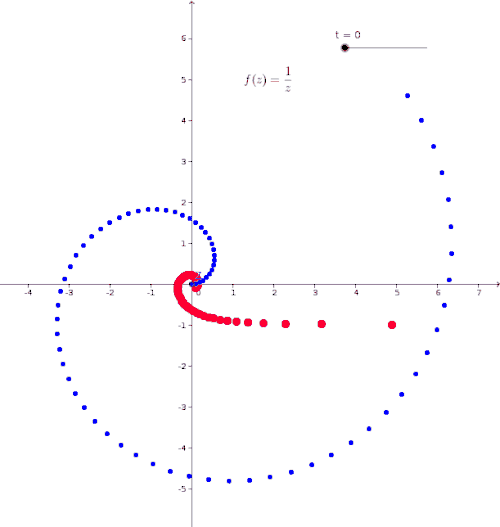Holomorphic function/Criteria
Introduction
Holomorphy of a function at a point is a neighborhood property of . There are numerous criteria in complex analysis that can be used to verify holomorphy. Let be a domain as a subset of the complex plane and a point in this subset.
Animation - Visualization of the Mapping
The animation shows the function . In the animation, is shown in blue, and the corresponding image point is shown in red. The point and are represented in . The -axis represents the imaginary part of the complex numbers and . The blue point moves along the path

Complex Differentiability
A function is called complex differentiable at the point if the limit exists with . This is denoted as .
Holomorphy
A function is called holomorphic at the point if there exists a neighborhood of such that is complex differentiable in . If is holomorphic on all of , it is simply called holomorphic. If additionally , is called an entire function.
Holomorphy Criteria
Let be a function where is a domain, then the following properties of the complex-valued function are equivalent:
(HK1) Once Complex Differentiable
The function is once complex differentiable on .
(HK2) Arbitrarily Often Complex Differentiable
The function is arbitrarily often complex differentiable on .
(HK3) Cauchy-Riemann Differential Equations
The real and imaginary parts satisfy the Cauchy-Riemann equations and are at least once continuously real-differentiable on .
(HK4) Locally Expansible in Power Series
The function can be locally expanded in a complex power series on .
(HK5) Path Integrals 0
The function is continuous, and the path integral of the function over any closed contractible path vanishes (i.e., the winding number of the path integral for all points outside of is 0).
(HK6) Cauchy Integral Formula
The function values inside a circular disk can be determined from the function values on the boundary using the Cauchy integral formula.
(HK7) Cauchy-Riemann Operator
is real differentiable, and , where is the Cauchy-Riemann operator defined by .
Exercises
Let be chosen arbitrarily, and assume that . Now, develop the function for in a power series around and show that the following holds:
Calculate the radius of convergence of the power series! Explain why the radius of convergence depends on in this way and cannot be larger!
It is not true in real analysis that the existence of a once differentiable function implies that the function is infinitely differentiable. Consider the function defined on all of .
Explain how the central theorem of Complex Analysis from criterion 1 leads to criterion 2!
See also
Page Information
You can display this page as Wiki2Reveal slides
Wiki2Reveal
The Wiki2Reveal slides were created for the Holomorphic function' and the Link for the Wiki2Reveal Slides was created with the link generator.
- This page is designed as a PanDocElectron-SLIDE document type.
- Source: Wikiversity https://en.wikiversity.org/wiki/Holomorphic%20function/Criteria
- see Wiki2Reveal for the functionality of Wiki2Reveal.
Translation and Version Control
This page was translated based on the following Wikiversity source page and uses the concept of Translation and Version Control for a transparent language fork in a Wikiversity:
- Source: Holomorphie/Kriterien
- URL: https://de.wikiversity.org/wiki/Holomorphie/Kriterien
- Date: 12/10/2024 9:56pm